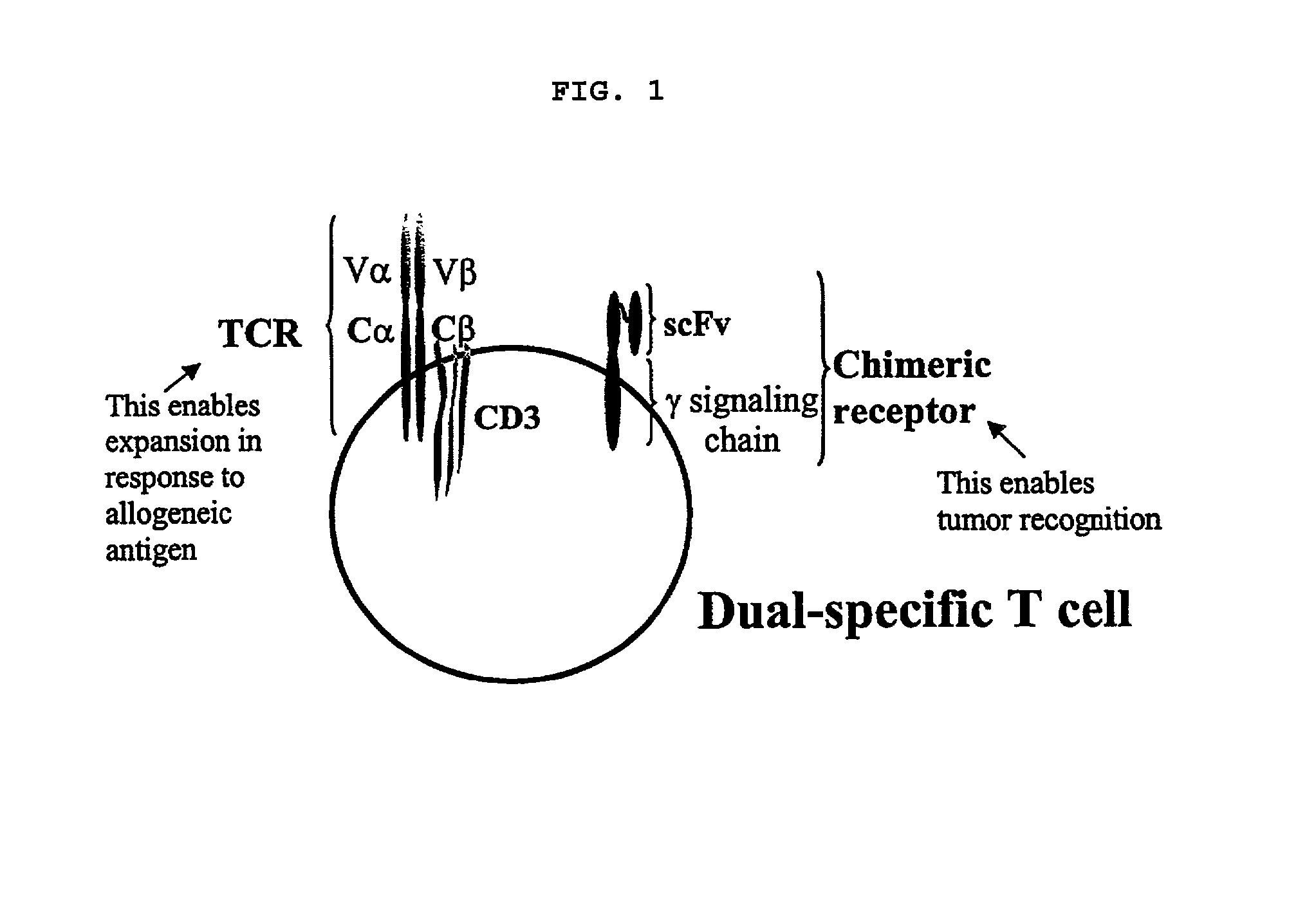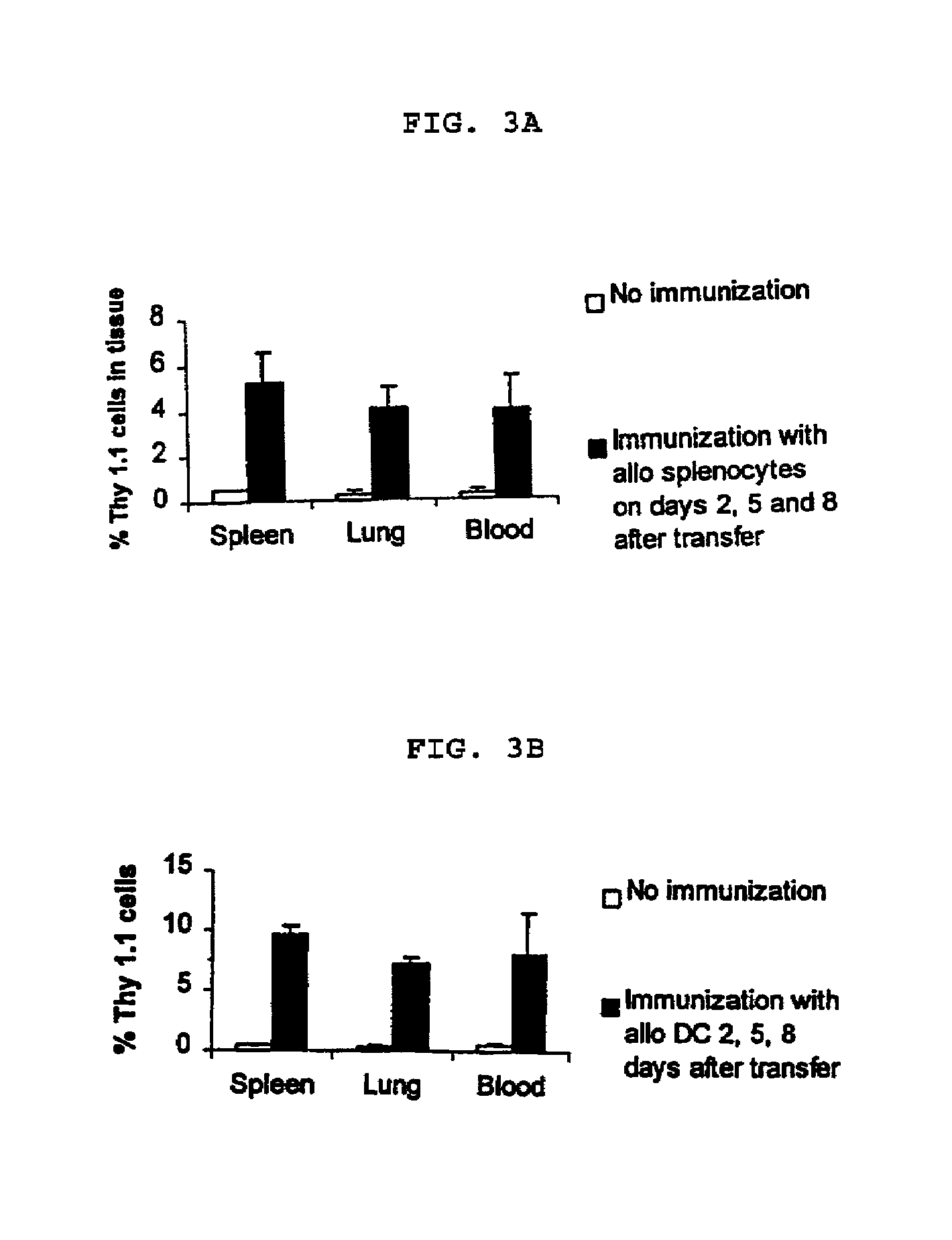Activated dual specificity lymphocytes and their methods of use
- Summary
- Abstract
- Description
- Claims
- Application Information
AI Technical Summary
Benefits of technology
Problems solved by technology
Method used
Image
Examples
example 1
Ineffective Treatment of Cancer Patients
[0075]Previously, chimeric receptors against ovarian cancer (MOv-γ) were found to be functional in primary T cells in vitro and in vivo [Hwu, P., et al. J. Exp. Med., 178:361-366, 1993; Hwu, P., et al., Cancer Res., 55:3369-3373, 1995]. The effects of treating eight patients with advanced ovarian cancer with T cells transduced with chimeric receptor genes derived from a monoclonal antibody against ovarian cancer, MOv-18 alone, and without any specificity were observed. Tumor-infiltrating lymphocytes (TIL) or anti-CD3 stimulated peripheral blood lymphocytes (PBL) retrovirally transduced with the MOv18 chimeric receptor gene (MOv-γ) were generated in large numbers of MOv-PBL which remained highly reactive against ovarian cancer cells in vitro prior to infusion. Patients were treated with up to 5×1010 transduced PBL for CD3 in combination with systemic IL-2 (120,000 CU / kg). The results of this clinical trial demonstrated that cells were directed ...
example 2
Functionality of MOv-PBL After Ineffective Treatment of Cancer Patients
[0076]In order to address the question as to why patients transduced with chimeric receptor genes did not respond to treatment although 10% of transduced cells were found circulating in one patient's PBMC analyzed after 5 days post MOv-PBL infusion, the functionality of MOv-PBL after cell transfer was determined. Fresh uncultured PBMC from the day 5 post MOv-PBL infusion time point were co-cultured with ovarian cancer cells or melanoma cells (888 mel or 1300 mel). Supernatants were assayed for IFN-γ by enzyme-linked immunosorbent assay (ELISA) and lysates were analyzed for IFN-γ mRNA using Taqman. No significant IFN-γ release was seen using the fresh day 5 PBMC. To reisolate the adoptively transferred MOv-PBL, the PBMC from day 5 were cultured in G418 (for neomycin resistant selection), anti-CD3, and IL-2. After 17 days, the culture was highly enriched for reisolated MOv-PBL (69% positive for gene) that were capa...
example 3
In vivo Expansion of Alloreactive Cultured T Cells in Murine Models
[0078]In order to determine the effects of allogeneic immunization of adoptively transferred T cells, anti-allogeneic mouse (C57BL / 6) T cells were raised in a mixed lymphocyte reaction (MLR) for 7 days and restimulated for 6 additional days. Thy 1.1+ alloreactive (H2-b anti-H2-d) T cells were generated and expanded and 1×107 cells were adoptively transferred into congenic C57BL / 6 mice (Thy 1.2) by intravenous injection. The C57BL / 6 mice were immunized with allogeneic antigen presenting cells from BALB / c mice on days 2, 5, and 8 after transfer. Where stimulators, for example, either allogeneic splenocytes or allogeneic dendritic cells (DC), were used to immunize the mice. Stimulators are strong antigenic agents which activate responder cells, for example lymphocytes. There were 3 mice per condition group. Tissues (spleen, lung, and blood) were harvested on day 11 and Thy 1.1 cells were quantified following staining an...
PUM
| Property | Measurement | Unit |
|---|---|---|
| Fraction | aaaaa | aaaaa |
| Fraction | aaaaa | aaaaa |
| Fraction | aaaaa | aaaaa |
Abstract
Description
Claims
Application Information
 Login to View More
Login to View More - R&D
- Intellectual Property
- Life Sciences
- Materials
- Tech Scout
- Unparalleled Data Quality
- Higher Quality Content
- 60% Fewer Hallucinations
Browse by: Latest US Patents, China's latest patents, Technical Efficacy Thesaurus, Application Domain, Technology Topic, Popular Technical Reports.
© 2025 PatSnap. All rights reserved.Legal|Privacy policy|Modern Slavery Act Transparency Statement|Sitemap|About US| Contact US: help@patsnap.com



